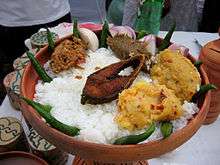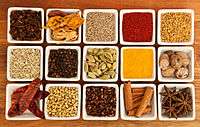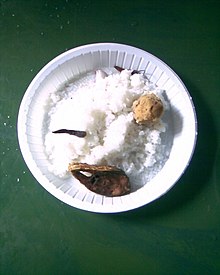Panta bhat
Panta bhat or poitabhat (Bengali: পান্তা ভাত; Pàntà bhàt; Assamese: পঁইতা ভাত) is rice-based dish prepared by soaking rice, generally leftover, in water overnight. Traditionally served in the morning with salt, onion, chili and bengali style mashed potatoes or "Aloo sheddho" (simple boilled potatoes mashed and salted without adding any cream or cheese).[1] It is consumed in eastern Indian states of Bihar, Odisha , West Bengal, Assam, Tripura and in neighbouring country Bangladesh. It is a popular dish on the day of Pahela Baishakh or Bengali new year. It has been described in documents from 17th century. Panta bhat has more micronutrients than fresh rice. It is traditionally considered as beneficial in feverish conditions.
 Panta Ilish - a traditional platter of Panta bhat with fried Ilish slice, supplemented with dried fish (Shutki), pickles (Achar), dal, green chillies and onion - is a popular serving for the Pahela Baishakh festival. | |
| Alternative names | পান্তা ভাত |
|---|---|
| Course | Main course |
| Place of origin | India, Bangladesh |
| Region or state | South Asia |
| Main ingredients | Rice, water |
| Variations | Pakhala |
 |
| This article is part of the series on |
| Indian cuisine |
|---|
|
Regional cuisines
|
|
Ingredients, types of food
|
|
See also
|
|
Related cuisines |
|
| Part of a series on the |
| Culture of Bangladesh |
|---|
 |
| History |
| Traditions |
|
Festivals
|
| Religion |
|
Genres Institutions Awards |
|
Music and performing arts Theatre People |
|
Media
|
| Sport |
|
Monuments |
|
History
Anthropologist Tapan Kumar Sanyal argues that proto-Australoid people of South Asia resorted the panta bhat because they cooked once a day, in the evening.[2] During the Mughal Era, members of socio-cultural organizations performed open air concerts, the audience listening to the concert and eating traditional food, particularly panta bhat.[3] Friar Sebastian Manrique reported from his visit of Bengal in 17th century that the people of all communities, according to Manrique, were contented then with the daily meal of rice, often panta bhat, salt and green vegetable (shak). The better-off elements of the society consumed ghee, butter, milk and various lacteous preparations and sweetmeats.[4]
Rice researcher Mahabub Hossain of International Rice Research Institute explains that in the past, people engaged in farm work preferred bold and brown rice which is more suited for watered rice, and also provides more nutrition. But, as more people shifted to urban centers the demand for farm work, brown rice and watered rice decreased. In these times of polished rice, the popularity of rice varieties like Lal Swarna and White Swarna is often driven by their suitability for panta bhat.[5]
Preparation
There are many variations of the dish though all are made by soaking cooked rice in water overnight. Rice is boiled the usual way. Then phaen or starch is strained away. Rice is cooled in air temperature for 3–4 hours. Then cool water is added in a way that about an inch of water rises above the rice. Rice is generally covered with a light piece of fabric. 12–24 hours later panta bhat is ready. Panta bhat retains its taste for 2/3 days. The fluid portion is called amani or torani, and may be specially prepared.[6] Care must be taken to cover the dish during the long soaking to avoid contamination.[7]
The soaked rice is usually eaten in the morning with salt, lime, chili (either raw or roasted) and onions (sliced or whole) mostly for flavor.[8][9] Panta bhat is often served with fried fish or vegetable curry or flattened rice (chira), dried cane or palm molasses (jaggery or gurh) and milk curd (doi).[10] Water is discarded before consumption. Sometimes edible oils may be added.[11] Panta bhat or poita bhat is often garnished with mustard oil, onion, chilli, pickle, and served with shutki mach (dried fish), machher jhol (fish curry), especially shorshe Ilish (ilish cooked with mustard seeds), aloo bhorta or aloo pitika (mashed potato), begun bhorta (mashed brinjal) and other bhorta or pitika (mashed food).
A similar dish consumed in the Indian states of Bihar as Maar Bhaat, Orissa, Jharkhand and Chhattisgarh is known as Pakhala (also pakhal], pokhalo or pakhal bhat). It differs from panta bhat in seasoning as yoghurt is sometimes added prior to the fermentation process.[12] Pazhedhu saadham, meaning "old rice", of Tamil Nadu is another variation of the dish.[13] It is consumed in East and South East Asia as well, and is known as Jiuniang in China.
Popularity

Panta bhat is especially popular in rural areas,[14][15] generally served with salt, raw onion and green chili.[16] It is usually served as breakfast,[15] though noon or evening consumption is not uncommon.[17][18] Panta bhat and other low nutrition food are consumed as fillers between meals.[19] Panta bhat is one of the cool dishes popular in Bengal, meaning it helps keep cool during the summer.[20] This cold and wet food, is suitable for summer mornings, but in winter dry foods, such as chira (flattened rice) and muri (puffed rice) are more preferred.[21]
In Bangladesh, as well West Bengal, it is a part of the Pahela Baishakh (Bengali new year festival) festivities. On that day it is consumed as breakfast by urban people.[22][23] Panta is also served at high-end eateries in Bangladesh[24][25] and West Bengal on the day.[26] Food-stalls maintained mostly by student groups on fair-grounds also serve panta-ilish.[27][28] Panta bhat on Pahela Baishakh is often served with fried hilsha (ilish), and students of Pabna Science and Technology University (PUST) assaulted their student counselor for not providing panta-ilish in the Pahela Baishakh of 2014.[29] But, the practice takes a toll on the hilsha population during the breeding season. Since 2016, Bangladesh government banned hilsha fishing and selling in the times of Pahela Baishakh, ministers started urging people to have panta without ilish and social media baceme rife with calls for panta without ilish.[30][31]
Among Hindu Bengalis, it is consumed during the Ranna Puja (Bengali cooking festival). During Ranna Puja, panta bhat is offered to Manasa the snake goddess along with fried vegetables, yellow pigeon peas cooked with elephant apples, curried ash gourd and fried Hilsa.[32] On the Vijayadashami day of Durga Puja, panta bhat is offered to Durga along with soup of grass pea, fried taro leaves, machher jhol of blue perch and chutney of elephant apple for Sabarna Roy Choudhury Atchala Durga in Kolkata.[33] In Assam, offering Dudh Panta (milk with stale water-soaked rice) is a part of the marital ritual.[34] In Northeast India, there is a belief that taking painta or panta bhat gives the strength of a tiger.[35] Panta bhat is also popular among slum-dwellers of Dhaka because it can be easily eaten only with salt or with an onion or a fried or green chili, without any other requirement.[36]
Most restaurants on NH34, which runs through Krishnanagar, Nadia, serve panta bhat in summer along with kasundi, mustard oil, kaffir lime, green chili, sliced onion, aloo chokha, fried red chili, Poppy seed balls, aloo jhuri bhaja, mango chutney, sour curd, and sweet paan.[37] Nabanno Hyderabad, a Bengali-owned restaurant in Kukatpally, Hyderabad, serve panta bhat all the year round.[38]
Proverbs
There are many folk rhymes and proverbs about panta bhat: shashuri nai nonod nai kar ba kori dar/agey khai panta bhat sheshe lepi ghar (lit. "no mother-in-law, no sister-in-law, whom do I fear/ shall eat watered rice first then clean the room"), maga bhat tay basi ar panta(lit. "got rice begging, ask not whether stale or watered"), ki katha bolbo sai/panta bhate tak dai (lit. "what do I say, sour curd on watered rice), panta bhate noon jote na/begun poday ghee (lit. "no salt in watered rice/ghee in roasted brinjal"), noon ante panta phuray (lit. "when salt arrives, the panta is finished"), mude mai radhe na/tapta ar panta (lit. "mother does not cook/so why ask hot or cold") and bandir kame yash nai/panta bhate kash nai (lit. "no merit in a maid's work/no fun in watered rice").[39]
Nutrition
In a study conducted by agricultural biotechnology department of the Assam Agricultural University it was concluded that cooked rice had an element that prevented the availability of minerals like iron, potassium, sodium and calcium in high quantities, and the breakdown of the nutritional inhibitor by the lactic acid bacteria increased the mineral content manifolds. According to Madhumita Barooah, one of the researchers, "About 100 gm of cooked rice has only 3.4 mg of iron, while for the same quantity of rice fermented for 12 hours, the iron content went up to 73.91 mg. Likewise, sodium, which was 475 mg came down to 303 mg, potassium went up to 839 mg and calcium went up from 21 mg per 100 gm of cooked rice to 850 mg, after 12 hours of fermentation of the same quantity of rice."[40] According to another study (ILSI 1998), fermentation improves the bioavailability of minerals such as iron and zinc as a result of phytic acid hydrolysis, and increases the content of riboflavin and vitamin B.[41]
Panta bhat has some remedial use. It is considered as a "cold food" by Ayurveda traditions, while boiled rice is neutral. Hence is a preferred food for children with a fever.[42] Panta bhat also contains a small amount of alcohol as a result of fermentation.[43] When the conditions of preparing panta bhat — keeping rice soaked overnight in water — were simulated in the laboratory, the rice was found to be inoculated with veratridine, a steroid-derived alkaloid.[44]
Despite its nutritional and remedial values, panta bhat is often contaminated, with almost 90% of the samples containing fecal coliforms with a median count of 3.9 log cfu/ml. The contamination was more in the rainy season. Numbers of fecal coliforms increased 10-fold when there was a delay of more than 4 hours between preparation and consumption; 90% of the samples were eaten more than 12 hours after preparation. Contamination increased during the rainy season.[7] A ten-fold increase in contamination was observed between 4 hours of soaking and 16 hours of soaking.[45] In cases of diarrhoea this stale rice is not to be served to the patient,[46] though boiled rice and rice-water are often prescribed as diarrheal treatment.[47]
See also
References
- Rao, Ranjini (2019-06-11). "A Scrumptious Affair: Why Aloo Sheddo/Mashed Potato is Dear to Me". TheQuint. Retrieved 2020-07-31.
- Tapan Kumar Sanyal, And Keeping the Flame Alive: A Study on Food Habits and Dietaries with Nutritional Efficiency of West Bengal Tribes, pages 104-105, Cultural Research Institute, Scheduled Castes and Tribes Welfare Department, Government of West Bengal, 1979
- Golam Rabbani (1997). Dhaka: From Mughal Outpost to Metropolis. Dhaka: University Press Limited. p. 168. ISBN 9789840513741.
- Sirajul Islam; Aklam Hussain, eds. (1997). History of Bangladesh, 1704-1971. Vol. 1, Political history. Asiatic Society of Bangladesh. p. 716. ISBN 9789845123372.
- Mahabub Hossain, Adoption and Diffusion of Modern Rice Varieties in Bangladesh and Eastern India, pages 37, 52, 98, International Rice Research Institute, 2012, ISBN 9712202860
- Jitendra Nath Rakshit (1916). "Rice, as Prepared for Food in Bengal". The Agricultural Journal of India. Calcutta: Government of India, Central Publication Branch for the Imperial Council of Agricultural Research. 11: 189. hdl:2027/uc1.b2938011.
- Brian J.B. Wood (1985). Microbiology of Fermented Foods. Springer. p. 796. ISBN 9780751402162.
- Akhter Hameed Khan, The Works of Akhter Hameed Khan (Volume 1), page 288, Bangladesh Academy for Rural Development, 1983
- Debates: official report (Volume 2, Issues 16-30), page 1092, Pakistan. National Assembly, 1966
- Enamul Haq (2012). "Customs and Traditions". In Islam, Sirajul; Jamal, Ahmed A. (eds.). Banglapedia: National Encyclopedia of Bangladesh (Second ed.). Asiatic Society of Bangladesh.
- Narendra S. Bisht and T. S. Bankoti, Encyclopaedic Ethnography of the Himalayan Tribes: R-Z (Volume 4), Page 1336, Global Vision, 2004, ISBN 9788187746959
- Panta bhat – A Forgotten Recipe, The Great Indian Taste
- Nandita Iyer,Not fresh, yet healthy, Live Mint, May 12, 2014
- "The Tiger of Bengal". Dawn Magazine. 2003-11-09. Archived from the original on 2007-07-13. Retrieved 2007-12-11.
- Enamul Haq (2012). "Food Habits". In Islam, Sirajul; Jamal, Ahmed A. (eds.). Banglapedia: National Encyclopedia of Bangladesh (Second ed.). Asiatic Society of Bangladesh.
- Bangladesh District Gazetteers: Patuakhali, page 99, Ministry of Cabinet Affairs (Establishment Division), Bangladesh Government Press, 1982
- Census of India (Volume 3, Part 6, Issue 3), 1961, Office of the Registrar General, India
- Ananya Roy, Calcutta Requiem: Gender And The Politics Of Poverty, page 81, Pearson Education India, 2007, ISBN 9788131712993
- Khondoker Mokaddem Hossain, Homestead forestry and rural development: a socio-empirical study of Bangladesh, page 108, Massey University
- Pritha Sen, Why are there few cold foods in Indian cuisine?, Live Mint, Jun 17 2016
- Paul Oswald Woolley, United States Office of International Health & United States Agency for International Development, Syncrisis: the Dynamics of Health, page 23, U.S. Office of International Health, Division of Planning and Evaluation, 1976
- Sambaru Chandra Mohanta (2012). "Pahela Baishakh". In Islam, Sirajul; Jamal, Ahmed A. (eds.). Banglapedia: National Encyclopedia of Bangladesh (Second ed.). Asiatic Society of Bangladesh.
- Tanvir Hafiz. "Out with the Old". Rising Stars. The Daily Star.
- "Corporate Watch". Financial Express. Dhaka. 2012-04-13.
- "Pan Pacific Sonargaon to celebrate Pohela Baishakh", The Bangladesh Monitor, 2014-06-05
- Bong Connection, The Telegraph (Kolkata)
- Sadya Afreen Mallick, Contemplating “Bangaliaana”, Daily Star, April 21, 2008
- Sanghamitra Saha, A Linguist Visits Bangladesh: A Travelogue, page 3, International School of Dravidian Linguistics, 2001
- Pabna Correspondent, Panta, Hilsa behind mischief, BDNews24, 2014-04-13
- Sahidul Hasan Khokon, Hilsa will not be a part of Pahela Baishakh celebrations in Dhaka, India Today, April 14, 2017
- Wasim Bin Habib and Shaheen Mollah, No-hilsa campaign worked well, Daily Star, April 16, 2016
- Priyadarshini Chatterjee, What India eats in the monsoon, scroll.in, Aug 08, 2017
- Priyadarshini Chatterjee, What does Goddess Durga feast on at ‘Bonedi Barir Pujo’?, Live Mint, Oct 04 2016
- Bīrendranātha Datta, A Study of the Folk Culture of the Goalpara Region of Assam, page 137, University Publication Department of Gauhati University, 1995
- Ballie Singha, Culture and Tradition of North East India, page 20, Vivekananda Kendra, 1996
- A. K. M. Ahsan Ullah, Abdar Rahman and Munira Murshed, Poverty and Migration - Slums of Dhaka City: The Realities, page 50, Association for Rural Development and Studies, 1999, ISBN 9789843106100
- Subhasish Chaudhuri, Meet the grand old cool kid of hot times - What grandma knew, hotels learn now, The Telegraph, June 11, 2015
- Restaurant Review: Nabanno Hyderabad for Bengali food, The Hans India
- Sudeshṇā Basāka, History of Bengali Proverbs, pages 16, 62, 66, 104, 131, 192, 202, 206, Gyan Publishing House, 2010, ISBN 8121210283
- Smita Bhattacharyya (2011-08-04). "Ferment rice for a healthy morsel". The Telegraph. Calcutta.
- Marie T. Ruel, Can Food-Based Strategies Help Reduce Vitamin A and Iron Deficiencies? Archived 2008-09-11 at the Wayback Machine, International Food Policy Research Institute, Washington, D.C., December 2001
- Clarence Maloney, K. M. Ashraful Aziz and Profulla Chandra Sarker, Beliefs and Fertility in Bangladesh, page 131, International Centre for Diarrhoeal Disease Research, Bangladesh, 1981
- Syed Nasrullah (2003-08-15). "Liberalising alcohol policy". The Daily Star.
- Hans Riemann, Food-borne Infections and Intoxications, page 266, Academic Press, 1969
- Kristy M Hendricks and Salma H Badruddin, Weaning and Diarrhoeal Disease, Journal of Diarrhoeal Diseases Research, page 8, ICDDR, B, Mar 1994
- India Ministry of Health and Family Welfare, Indian Market Research Bureau, UNICEF & United States Agency for International Development, Diarrhoea in Rural India: A Nationwide Study of Mothers and Practitioners, page 54, Vision Books, 1990
- H. B. Wong, Rice water in treatment of infantile gastroenteritis, The Lancet, 1981 Jul 11
External links
- l Cook up some panta bhat, Get Bengal